Saddam Hussein Trial: Case Study of Crimes Against Humanity
VerifiedAdded on 2023/06/11
|7
|2054
|262
AI Summary
This report covers the trial of Saddam Hussein for his crimes against humanity, including the persecution and killing of Kurdish people in Iraq. It includes a timeline of key events, a list of his crimes, and a conclusion on his capture and execution.
Contribute Materials
Your contribution can guide someone’s learning journey. Share your
documents today.
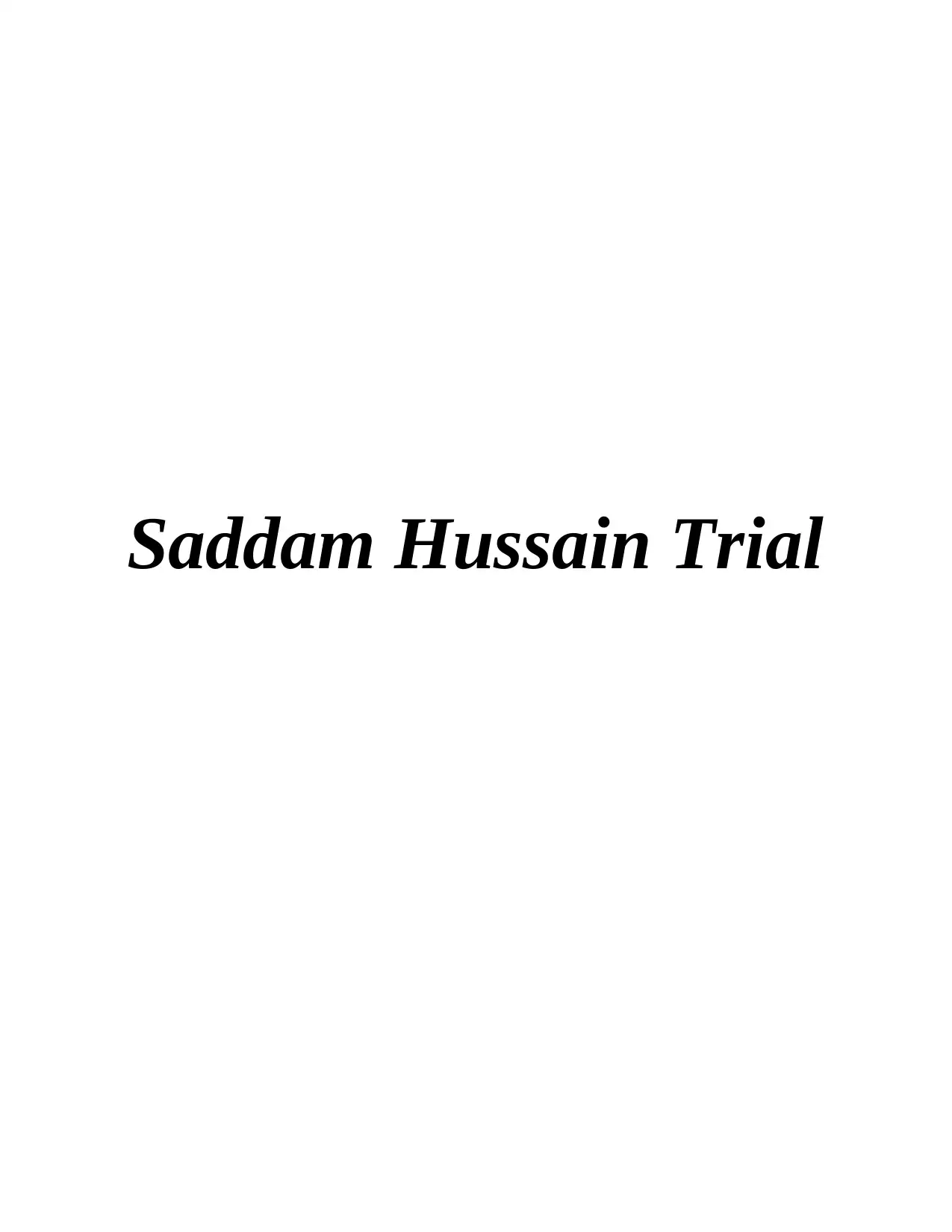
Saddam Hussain Trial
Secure Best Marks with AI Grader
Need help grading? Try our AI Grader for instant feedback on your assignments.

Table of Contents
Introduction......................................................................................................................................3
Main Body.......................................................................................................................................3
Conclusion.......................................................................................................................................6
References........................................................................................................................................7
Introduction......................................................................................................................................3
Main Body.......................................................................................................................................3
Conclusion.......................................................................................................................................6
References........................................................................................................................................7
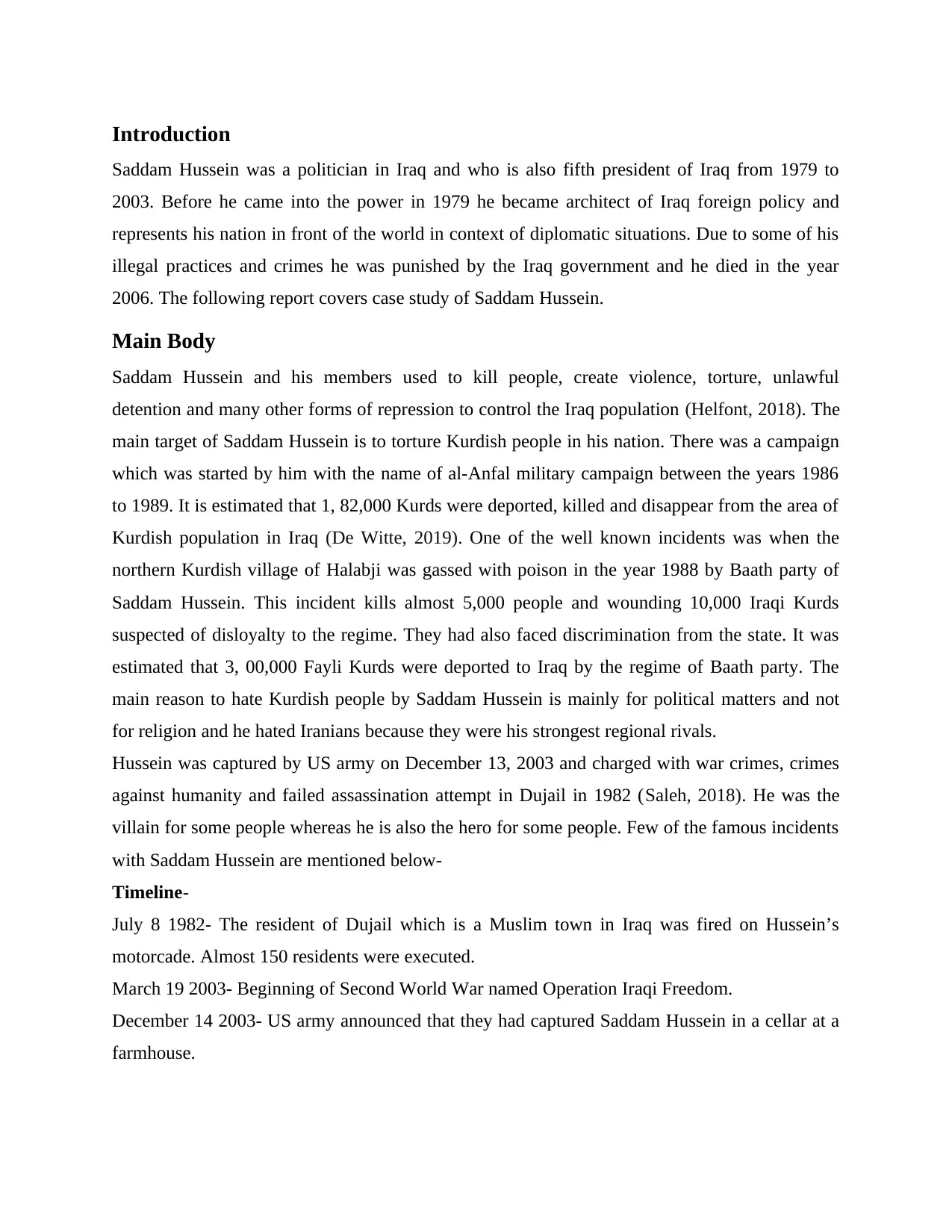
Introduction
Saddam Hussein was a politician in Iraq and who is also fifth president of Iraq from 1979 to
2003. Before he came into the power in 1979 he became architect of Iraq foreign policy and
represents his nation in front of the world in context of diplomatic situations. Due to some of his
illegal practices and crimes he was punished by the Iraq government and he died in the year
2006. The following report covers case study of Saddam Hussein.
Main Body
Saddam Hussein and his members used to kill people, create violence, torture, unlawful
detention and many other forms of repression to control the Iraq population (Helfont, 2018). The
main target of Saddam Hussein is to torture Kurdish people in his nation. There was a campaign
which was started by him with the name of al-Anfal military campaign between the years 1986
to 1989. It is estimated that 1, 82,000 Kurds were deported, killed and disappear from the area of
Kurdish population in Iraq (De Witte, 2019). One of the well known incidents was when the
northern Kurdish village of Halabji was gassed with poison in the year 1988 by Baath party of
Saddam Hussein. This incident kills almost 5,000 people and wounding 10,000 Iraqi Kurds
suspected of disloyalty to the regime. They had also faced discrimination from the state. It was
estimated that 3, 00,000 Fayli Kurds were deported to Iraq by the regime of Baath party. The
main reason to hate Kurdish people by Saddam Hussein is mainly for political matters and not
for religion and he hated Iranians because they were his strongest regional rivals.
Hussein was captured by US army on December 13, 2003 and charged with war crimes, crimes
against humanity and failed assassination attempt in Dujail in 1982 (Saleh, 2018). He was the
villain for some people whereas he is also the hero for some people. Few of the famous incidents
with Saddam Hussein are mentioned below-
Timeline-
July 8 1982- The resident of Dujail which is a Muslim town in Iraq was fired on Hussein’s
motorcade. Almost 150 residents were executed.
March 19 2003- Beginning of Second World War named Operation Iraqi Freedom.
December 14 2003- US army announced that they had captured Saddam Hussein in a cellar at a
farmhouse.
Saddam Hussein was a politician in Iraq and who is also fifth president of Iraq from 1979 to
2003. Before he came into the power in 1979 he became architect of Iraq foreign policy and
represents his nation in front of the world in context of diplomatic situations. Due to some of his
illegal practices and crimes he was punished by the Iraq government and he died in the year
2006. The following report covers case study of Saddam Hussein.
Main Body
Saddam Hussein and his members used to kill people, create violence, torture, unlawful
detention and many other forms of repression to control the Iraq population (Helfont, 2018). The
main target of Saddam Hussein is to torture Kurdish people in his nation. There was a campaign
which was started by him with the name of al-Anfal military campaign between the years 1986
to 1989. It is estimated that 1, 82,000 Kurds were deported, killed and disappear from the area of
Kurdish population in Iraq (De Witte, 2019). One of the well known incidents was when the
northern Kurdish village of Halabji was gassed with poison in the year 1988 by Baath party of
Saddam Hussein. This incident kills almost 5,000 people and wounding 10,000 Iraqi Kurds
suspected of disloyalty to the regime. They had also faced discrimination from the state. It was
estimated that 3, 00,000 Fayli Kurds were deported to Iraq by the regime of Baath party. The
main reason to hate Kurdish people by Saddam Hussein is mainly for political matters and not
for religion and he hated Iranians because they were his strongest regional rivals.
Hussein was captured by US army on December 13, 2003 and charged with war crimes, crimes
against humanity and failed assassination attempt in Dujail in 1982 (Saleh, 2018). He was the
villain for some people whereas he is also the hero for some people. Few of the famous incidents
with Saddam Hussein are mentioned below-
Timeline-
July 8 1982- The resident of Dujail which is a Muslim town in Iraq was fired on Hussein’s
motorcade. Almost 150 residents were executed.
March 19 2003- Beginning of Second World War named Operation Iraqi Freedom.
December 14 2003- US army announced that they had captured Saddam Hussein in a cellar at a
farmhouse.

July 1 2004- On this day Hussein appear first time in the court to verify his charges on his many
crimes on Kurdish people and invasion of Kuwait.
November 2004-The family member of Hussein fires his chief lawyer Mohammad al- Rashdan.
Ziad al Khasawneh is now a new lawyer.
July 7 2005- Khasawneh resign the case because American defence team wasn’t to handle the
case by their way.
July 17 2005- The Iraqi Special Tribunal files the first criminal charge against Hussein in the
1982 for killing 148 people in Dujail.
August 23 2005- Hussein confirms that he ordered to kill his all previous lawyers and now he is
solely represented by Khalil Dulaimi.
September 6 2005- Hussein confirmed that he has ordered for the gas attack for thousands of
Kurds in the year 1982.
On 5 November 2006, Saddam Hussein was sentenced to death by hanging for the killing of 148
Shiites from Dujail, in retaliation for the assassination attempt of 8 July 1982 (Einolf, 2021).
When the judge announced the verdict, Saddam shouted, "Long live the people. Long live the
Arab nation (Huber, 2019). Down with the spies. God is great." Chief defense lawyer Khalil al-
Dulaimi later quoted a statement from Saddam Hussein given just before the Court issued its
verdict. He said that Saddam urged his countrymen to "unify in the face of sectarian strife". Al-
Dulaimi added that Saddam's message to the people was to "pardon and do not take revenge on
the invading nations, its civilians". An appeal, mandated by the Iraqi judicial system, followed.
There was speculation that the appeals could last years, postponing his actual execution.
However, on 26 December, Saddam's appeal was rejected and the death sentence was given. No
further appeals were possible and Saddam had to be executed within 30 days of that date (Einolf,
2018). The decision still had to be ratified by the Iraqi President but could not be commuted.
Judge Arif Shaheen, one of the nine appeal judges, said, "It cannot exceed 30 days. As from
tomorrow the sentence could be carried out at any time. The appeals court has issued its verdict.
What we have decided today is compulsory."
List of Saddam Hussein’s crimes-
1974 -- Dawa Killings- Saddam is a well known politician of his nation and he has accused to
kill 5 other political leaders of his opponent political party who raise their voice against Saddam.
In the year 2004, many of the charges were announced against Saddam.
crimes on Kurdish people and invasion of Kuwait.
November 2004-The family member of Hussein fires his chief lawyer Mohammad al- Rashdan.
Ziad al Khasawneh is now a new lawyer.
July 7 2005- Khasawneh resign the case because American defence team wasn’t to handle the
case by their way.
July 17 2005- The Iraqi Special Tribunal files the first criminal charge against Hussein in the
1982 for killing 148 people in Dujail.
August 23 2005- Hussein confirms that he ordered to kill his all previous lawyers and now he is
solely represented by Khalil Dulaimi.
September 6 2005- Hussein confirmed that he has ordered for the gas attack for thousands of
Kurds in the year 1982.
On 5 November 2006, Saddam Hussein was sentenced to death by hanging for the killing of 148
Shiites from Dujail, in retaliation for the assassination attempt of 8 July 1982 (Einolf, 2021).
When the judge announced the verdict, Saddam shouted, "Long live the people. Long live the
Arab nation (Huber, 2019). Down with the spies. God is great." Chief defense lawyer Khalil al-
Dulaimi later quoted a statement from Saddam Hussein given just before the Court issued its
verdict. He said that Saddam urged his countrymen to "unify in the face of sectarian strife". Al-
Dulaimi added that Saddam's message to the people was to "pardon and do not take revenge on
the invading nations, its civilians". An appeal, mandated by the Iraqi judicial system, followed.
There was speculation that the appeals could last years, postponing his actual execution.
However, on 26 December, Saddam's appeal was rejected and the death sentence was given. No
further appeals were possible and Saddam had to be executed within 30 days of that date (Einolf,
2018). The decision still had to be ratified by the Iraqi President but could not be commuted.
Judge Arif Shaheen, one of the nine appeal judges, said, "It cannot exceed 30 days. As from
tomorrow the sentence could be carried out at any time. The appeals court has issued its verdict.
What we have decided today is compulsory."
List of Saddam Hussein’s crimes-
1974 -- Dawa Killings- Saddam is a well known politician of his nation and he has accused to
kill 5 other political leaders of his opponent political party who raise their voice against Saddam.
In the year 2004, many of the charges were announced against Saddam.
Secure Best Marks with AI Grader
Need help grading? Try our AI Grader for instant feedback on your assignments.
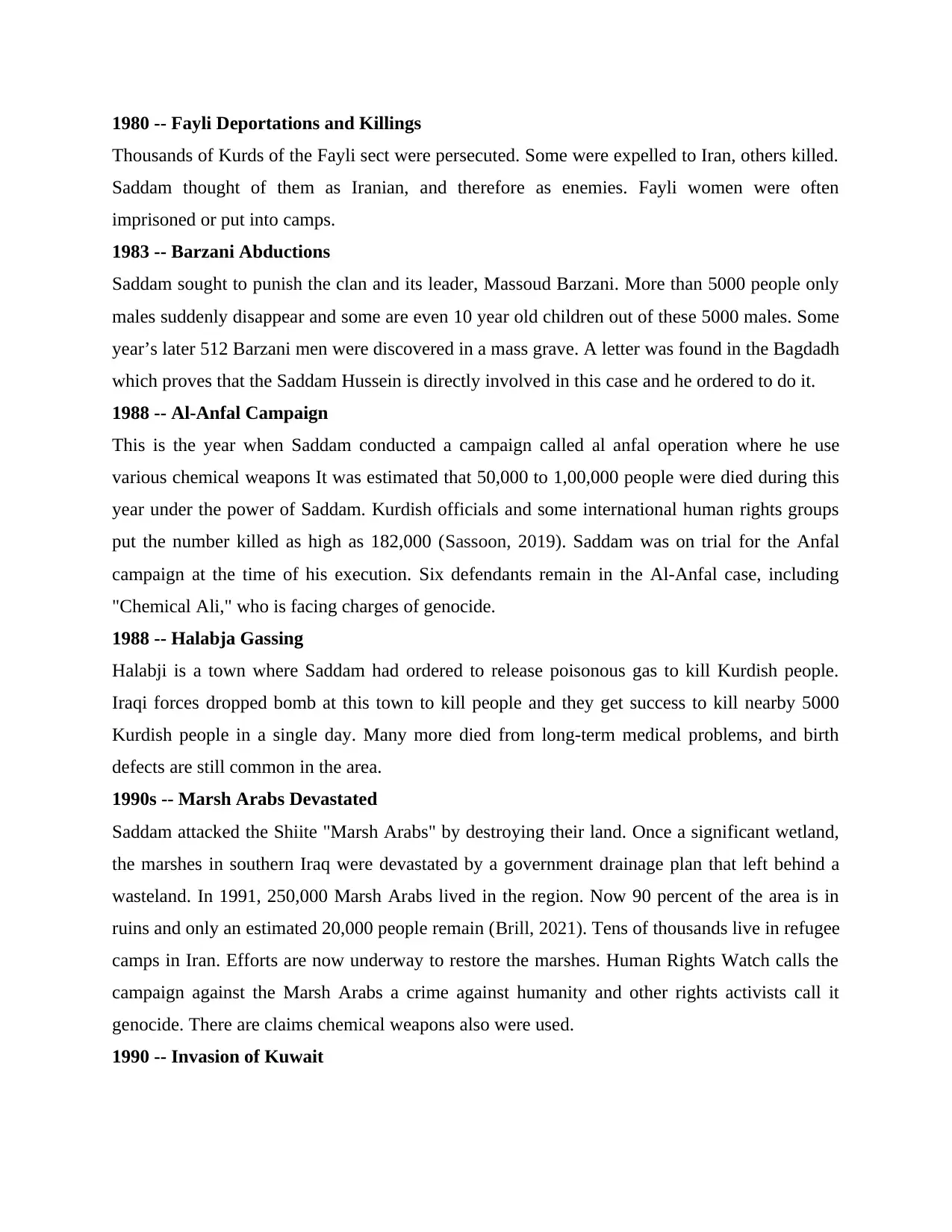
1980 -- Fayli Deportations and Killings
Thousands of Kurds of the Fayli sect were persecuted. Some were expelled to Iran, others killed.
Saddam thought of them as Iranian, and therefore as enemies. Fayli women were often
imprisoned or put into camps.
1983 -- Barzani Abductions
Saddam sought to punish the clan and its leader, Massoud Barzani. More than 5000 people only
males suddenly disappear and some are even 10 year old children out of these 5000 males. Some
year’s later 512 Barzani men were discovered in a mass grave. A letter was found in the Bagdadh
which proves that the Saddam Hussein is directly involved in this case and he ordered to do it.
1988 -- Al-Anfal Campaign
This is the year when Saddam conducted a campaign called al anfal operation where he use
various chemical weapons It was estimated that 50,000 to 1,00,000 people were died during this
year under the power of Saddam. Kurdish officials and some international human rights groups
put the number killed as high as 182,000 (Sassoon, 2019). Saddam was on trial for the Anfal
campaign at the time of his execution. Six defendants remain in the Al-Anfal case, including
"Chemical Ali," who is facing charges of genocide.
1988 -- Halabja Gassing
Halabji is a town where Saddam had ordered to release poisonous gas to kill Kurdish people.
Iraqi forces dropped bomb at this town to kill people and they get success to kill nearby 5000
Kurdish people in a single day. Many more died from long-term medical problems, and birth
defects are still common in the area.
1990s -- Marsh Arabs Devastated
Saddam attacked the Shiite "Marsh Arabs" by destroying their land. Once a significant wetland,
the marshes in southern Iraq were devastated by a government drainage plan that left behind a
wasteland. In 1991, 250,000 Marsh Arabs lived in the region. Now 90 percent of the area is in
ruins and only an estimated 20,000 people remain (Brill, 2021). Tens of thousands live in refugee
camps in Iran. Efforts are now underway to restore the marshes. Human Rights Watch calls the
campaign against the Marsh Arabs a crime against humanity and other rights activists call it
genocide. There are claims chemical weapons also were used.
1990 -- Invasion of Kuwait
Thousands of Kurds of the Fayli sect were persecuted. Some were expelled to Iran, others killed.
Saddam thought of them as Iranian, and therefore as enemies. Fayli women were often
imprisoned or put into camps.
1983 -- Barzani Abductions
Saddam sought to punish the clan and its leader, Massoud Barzani. More than 5000 people only
males suddenly disappear and some are even 10 year old children out of these 5000 males. Some
year’s later 512 Barzani men were discovered in a mass grave. A letter was found in the Bagdadh
which proves that the Saddam Hussein is directly involved in this case and he ordered to do it.
1988 -- Al-Anfal Campaign
This is the year when Saddam conducted a campaign called al anfal operation where he use
various chemical weapons It was estimated that 50,000 to 1,00,000 people were died during this
year under the power of Saddam. Kurdish officials and some international human rights groups
put the number killed as high as 182,000 (Sassoon, 2019). Saddam was on trial for the Anfal
campaign at the time of his execution. Six defendants remain in the Al-Anfal case, including
"Chemical Ali," who is facing charges of genocide.
1988 -- Halabja Gassing
Halabji is a town where Saddam had ordered to release poisonous gas to kill Kurdish people.
Iraqi forces dropped bomb at this town to kill people and they get success to kill nearby 5000
Kurdish people in a single day. Many more died from long-term medical problems, and birth
defects are still common in the area.
1990s -- Marsh Arabs Devastated
Saddam attacked the Shiite "Marsh Arabs" by destroying their land. Once a significant wetland,
the marshes in southern Iraq were devastated by a government drainage plan that left behind a
wasteland. In 1991, 250,000 Marsh Arabs lived in the region. Now 90 percent of the area is in
ruins and only an estimated 20,000 people remain (Brill, 2021). Tens of thousands live in refugee
camps in Iran. Efforts are now underway to restore the marshes. Human Rights Watch calls the
campaign against the Marsh Arabs a crime against humanity and other rights activists call it
genocide. There are claims chemical weapons also were used.
1990 -- Invasion of Kuwait
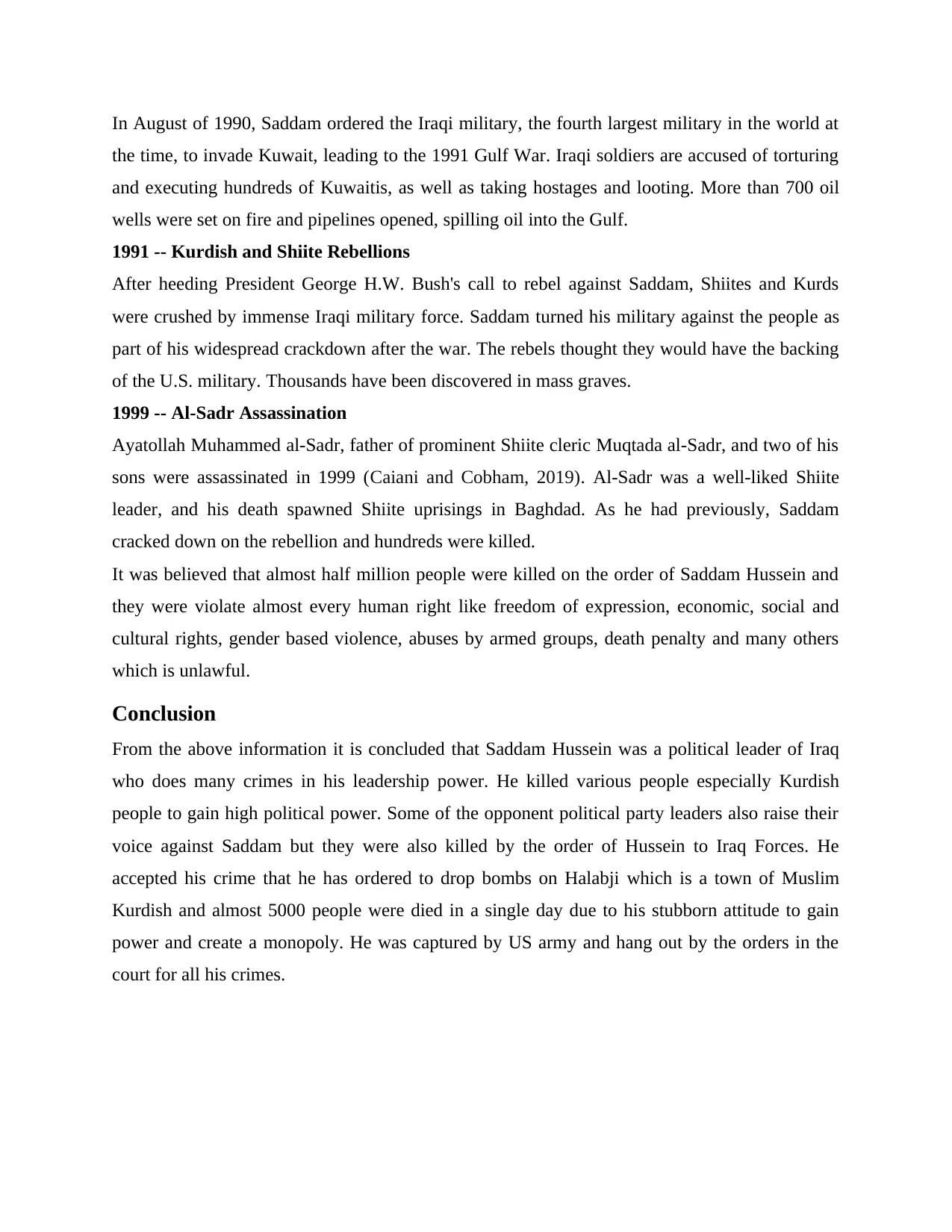
In August of 1990, Saddam ordered the Iraqi military, the fourth largest military in the world at
the time, to invade Kuwait, leading to the 1991 Gulf War. Iraqi soldiers are accused of torturing
and executing hundreds of Kuwaitis, as well as taking hostages and looting. More than 700 oil
wells were set on fire and pipelines opened, spilling oil into the Gulf.
1991 -- Kurdish and Shiite Rebellions
After heeding President George H.W. Bush's call to rebel against Saddam, Shiites and Kurds
were crushed by immense Iraqi military force. Saddam turned his military against the people as
part of his widespread crackdown after the war. The rebels thought they would have the backing
of the U.S. military. Thousands have been discovered in mass graves.
1999 -- Al-Sadr Assassination
Ayatollah Muhammed al-Sadr, father of prominent Shiite cleric Muqtada al-Sadr, and two of his
sons were assassinated in 1999 (Caiani and Cobham, 2019). Al-Sadr was a well-liked Shiite
leader, and his death spawned Shiite uprisings in Baghdad. As he had previously, Saddam
cracked down on the rebellion and hundreds were killed.
It was believed that almost half million people were killed on the order of Saddam Hussein and
they were violate almost every human right like freedom of expression, economic, social and
cultural rights, gender based violence, abuses by armed groups, death penalty and many others
which is unlawful.
Conclusion
From the above information it is concluded that Saddam Hussein was a political leader of Iraq
who does many crimes in his leadership power. He killed various people especially Kurdish
people to gain high political power. Some of the opponent political party leaders also raise their
voice against Saddam but they were also killed by the order of Hussein to Iraq Forces. He
accepted his crime that he has ordered to drop bombs on Halabji which is a town of Muslim
Kurdish and almost 5000 people were died in a single day due to his stubborn attitude to gain
power and create a monopoly. He was captured by US army and hang out by the orders in the
court for all his crimes.
the time, to invade Kuwait, leading to the 1991 Gulf War. Iraqi soldiers are accused of torturing
and executing hundreds of Kuwaitis, as well as taking hostages and looting. More than 700 oil
wells were set on fire and pipelines opened, spilling oil into the Gulf.
1991 -- Kurdish and Shiite Rebellions
After heeding President George H.W. Bush's call to rebel against Saddam, Shiites and Kurds
were crushed by immense Iraqi military force. Saddam turned his military against the people as
part of his widespread crackdown after the war. The rebels thought they would have the backing
of the U.S. military. Thousands have been discovered in mass graves.
1999 -- Al-Sadr Assassination
Ayatollah Muhammed al-Sadr, father of prominent Shiite cleric Muqtada al-Sadr, and two of his
sons were assassinated in 1999 (Caiani and Cobham, 2019). Al-Sadr was a well-liked Shiite
leader, and his death spawned Shiite uprisings in Baghdad. As he had previously, Saddam
cracked down on the rebellion and hundreds were killed.
It was believed that almost half million people were killed on the order of Saddam Hussein and
they were violate almost every human right like freedom of expression, economic, social and
cultural rights, gender based violence, abuses by armed groups, death penalty and many others
which is unlawful.
Conclusion
From the above information it is concluded that Saddam Hussein was a political leader of Iraq
who does many crimes in his leadership power. He killed various people especially Kurdish
people to gain high political power. Some of the opponent political party leaders also raise their
voice against Saddam but they were also killed by the order of Hussein to Iraq Forces. He
accepted his crime that he has ordered to drop bombs on Halabji which is a town of Muslim
Kurdish and almost 5000 people were died in a single day due to his stubborn attitude to gain
power and create a monopoly. He was captured by US army and hang out by the orders in the
court for all his crimes.
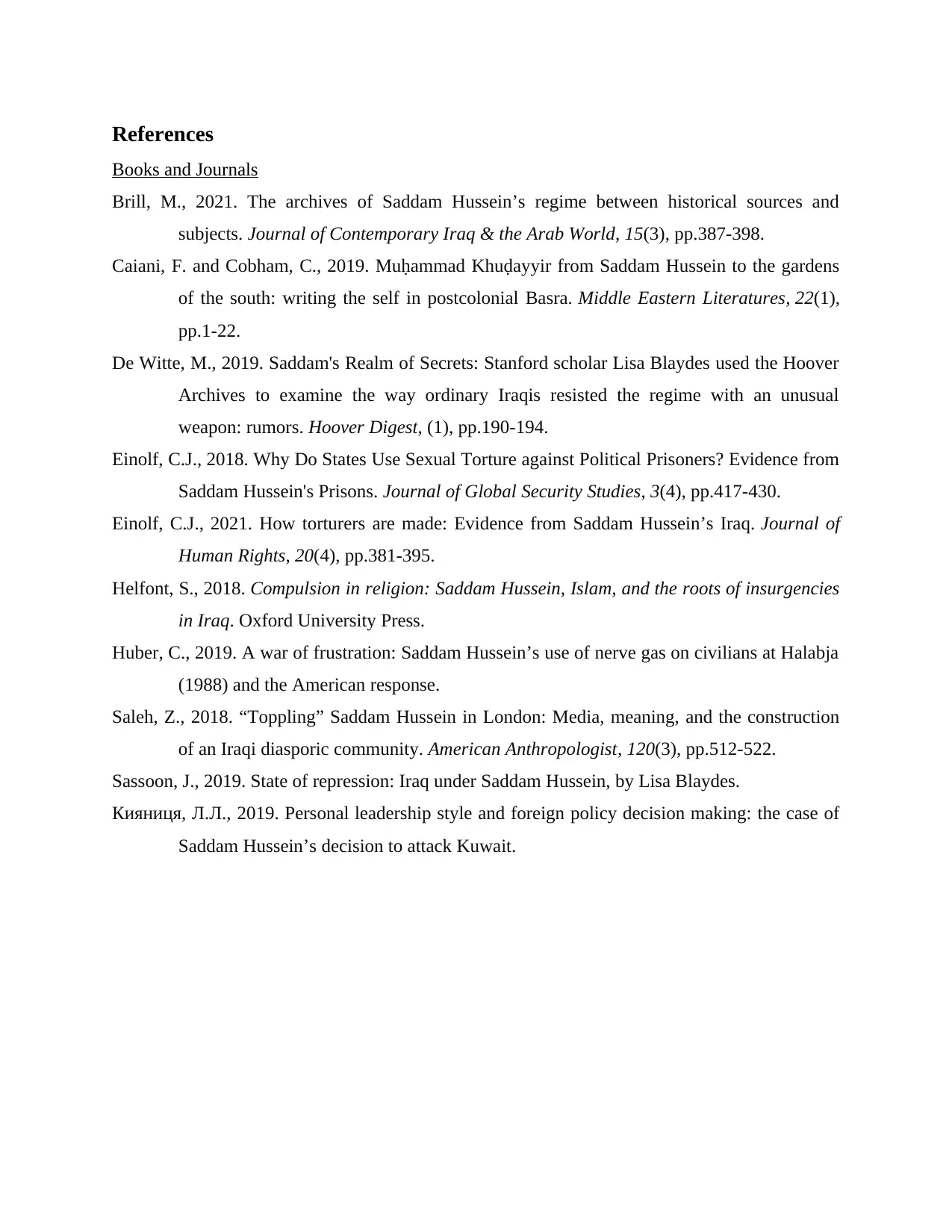
References
Books and Journals
Brill, M., 2021. The archives of Saddam Hussein’s regime between historical sources and
subjects. Journal of Contemporary Iraq & the Arab World, 15(3), pp.387-398.
Caiani, F. and Cobham, C., 2019. Muḥammad Khuḍayyir from Saddam Hussein to the gardens
of the south: writing the self in postcolonial Basra. Middle Eastern Literatures, 22(1),
pp.1-22.
De Witte, M., 2019. Saddam's Realm of Secrets: Stanford scholar Lisa Blaydes used the Hoover
Archives to examine the way ordinary Iraqis resisted the regime with an unusual
weapon: rumors. Hoover Digest, (1), pp.190-194.
Einolf, C.J., 2018. Why Do States Use Sexual Torture against Political Prisoners? Evidence from
Saddam Hussein's Prisons. Journal of Global Security Studies, 3(4), pp.417-430.
Einolf, C.J., 2021. How torturers are made: Evidence from Saddam Hussein’s Iraq. Journal of
Human Rights, 20(4), pp.381-395.
Helfont, S., 2018. Compulsion in religion: Saddam Hussein, Islam, and the roots of insurgencies
in Iraq. Oxford University Press.
Huber, C., 2019. A war of frustration: Saddam Hussein’s use of nerve gas on civilians at Halabja
(1988) and the American response.
Saleh, Z., 2018. “Toppling” Saddam Hussein in London: Media, meaning, and the construction
of an Iraqi diasporic community. American Anthropologist, 120(3), pp.512-522.
Sassoon, J., 2019. State of repression: Iraq under Saddam Hussein, by Lisa Blaydes.
Кияниця, Л.Л., 2019. Personal leadership style and foreign policy decision making: the case of
Saddam Hussein’s decision to attack Kuwait.
Books and Journals
Brill, M., 2021. The archives of Saddam Hussein’s regime between historical sources and
subjects. Journal of Contemporary Iraq & the Arab World, 15(3), pp.387-398.
Caiani, F. and Cobham, C., 2019. Muḥammad Khuḍayyir from Saddam Hussein to the gardens
of the south: writing the self in postcolonial Basra. Middle Eastern Literatures, 22(1),
pp.1-22.
De Witte, M., 2019. Saddam's Realm of Secrets: Stanford scholar Lisa Blaydes used the Hoover
Archives to examine the way ordinary Iraqis resisted the regime with an unusual
weapon: rumors. Hoover Digest, (1), pp.190-194.
Einolf, C.J., 2018. Why Do States Use Sexual Torture against Political Prisoners? Evidence from
Saddam Hussein's Prisons. Journal of Global Security Studies, 3(4), pp.417-430.
Einolf, C.J., 2021. How torturers are made: Evidence from Saddam Hussein’s Iraq. Journal of
Human Rights, 20(4), pp.381-395.
Helfont, S., 2018. Compulsion in religion: Saddam Hussein, Islam, and the roots of insurgencies
in Iraq. Oxford University Press.
Huber, C., 2019. A war of frustration: Saddam Hussein’s use of nerve gas on civilians at Halabja
(1988) and the American response.
Saleh, Z., 2018. “Toppling” Saddam Hussein in London: Media, meaning, and the construction
of an Iraqi diasporic community. American Anthropologist, 120(3), pp.512-522.
Sassoon, J., 2019. State of repression: Iraq under Saddam Hussein, by Lisa Blaydes.
Кияниця, Л.Л., 2019. Personal leadership style and foreign policy decision making: the case of
Saddam Hussein’s decision to attack Kuwait.
1 out of 7
Your All-in-One AI-Powered Toolkit for Academic Success.
+13062052269
info@desklib.com
Available 24*7 on WhatsApp / Email
![[object Object]](/_next/static/media/star-bottom.7253800d.svg)
Unlock your academic potential
© 2024 | Zucol Services PVT LTD | All rights reserved.

